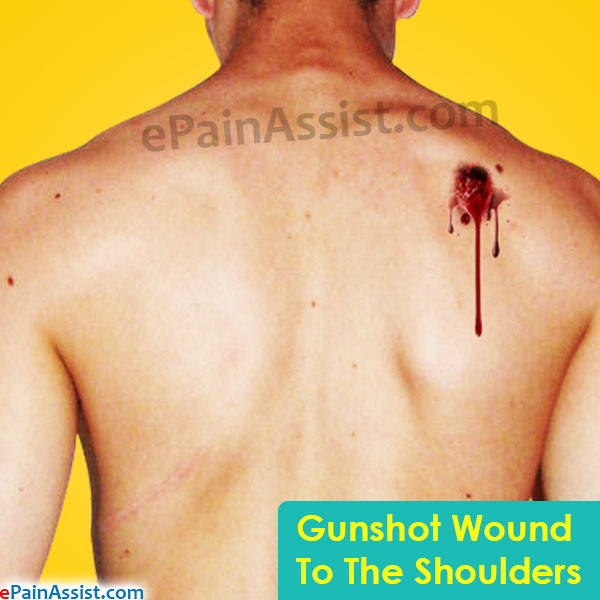Gunshot wounds occur due to a projectile shot from a firearm. The shooting could result from suicidal intention, purposeful or accidental firing. The bullet, once shot, travels along the path and hits the aimed target. It enters the body by crushing the tissue and causes damage to the internal structures.
Gunshot wound may show only entry wound or sometimes even exit wound as the bullet leaves the body through the other end. The amount of damage caused and the severity of injuries depends on characteristics of the bullet and the gun, the projectile path, the range of shooting and the type and nature of tissue that is affected.
Injuries Sustained In Gunshot Wound to Shoulders
The anatomical structure of shoulders is such that there are bones, joints, muscles, soft tissues, blood vessels and nerves all surrounded in a comparatively narrow region. Any injury to the area can cause damage to these structures and consequences may vary depending on the part injured. Gunshot wounds to shoulders can range from the area below the neck extending up to the shoulders and upper arms. The shoulder joint has many structures involved and gunshot wounds can cause varying degrees of injury.
Injury to the Soft Tissue– Soft tissues like muscles, ligaments, cartilages, etc surrounding the shoulder joint may get injured and damaged due to gunshot wound to the shoulder. In most cases surgical exploration is urgently required and debridement of the damaged tissue is performed. Any additional injuries in the area are also identified and need to be repaired.
Injury to the Shoulder Joint or Fracture– If gunshot wounds occur to the articulation of the shoulder joint, meticulous evaluation is necessary to rule out the presence of bullet fragments in the area. In case these fragments are detected by appropriate investigations or suspected, relevant procedures using arthroscopic techniques are used. With the help of this minimally invasive method, the debriding of the injured joint and removal of bullet fragments or foreign bodies is possible.
In case of shoulder joint or the long bone of arm (humerus) is fractured, there are chances of arterial injury supplying the hands, for example subclavian artery and others. Appropriate investigations need to be done to detect these types of vascular injuries. Angiography to identify the blood flow and arterial damage may be performed if required.
Injury to the Nerves– Nerve injuries of the shoulder joint are crucial and challenging due to the presence of brachial plexus in the area. This comprises nerve structures that supply to the upper body, arms and hands. Any damage to these nerves can result in neurological deficits and needs to be dealt with proper care. Generally, neurological deficits due to nerve injury may recover after few months. In other cases or when expected recovery is not visible additional investigations to detect nerve damage and required treatment may be performed.
Treatment of Gunshot Wound to the Shoulder
Treatment in case of fracture to the shoulder joint generally involves bracing and appropriate rehabilitation. The need for fixation is assessed and appropriate measures are taken. A course of appropriate antibiotics is given to prevent the chances of infection and local wound care is advised. For low velocity gunshot wounds, surgical stabilization may be required in patients with shoulder fracture. For high-velocity gunshot wounds, shoulder injuries may usually require operative intervention for debridement. This may also be followed by additional treatment of fractures.
In treating soft tissue injuries, surgical debridement is performed. Use of antibiotics before the procedure, dressing and proper wound care is essential. Procedures for wound closure are performed and follow-up surgeries may also be required.
If arterial injury is detected in patients sustaining gunshot wounds to the shoulders, surgical exploration may be performed urgently. Additionally, stabilization of the joint and the bone is required and appropriate measures to regularize the blood flow are taken. In these as well as patients without obvious arterial injury, observation is warranted. Skin grafting may be required and is performed depending on the case.
For nerve injuries that do not recover, investigations like electromyography and nerve conductions studies are performed to detect the flow of signals through the nerves. Treatment may include nerve exploration, resection of neuroma and repair or grafting as indicated.
Emergency Treatment for Gunshot Wound to the Shoulder
As the exact type of injuries is not clear, immediate help in case of gunshot wound to the shoulders should be executed with care and extreme caution. The stability of the patient is assessed by evaluating airways, breathing, consciousness, pulse and blood pressure.
In case of bleeding, applying direct pressure helps. Additionally elevation of the arm and applying a pressure bandage may be required. If swelling is noted, there may be internal bleeding and possible bone and joint injury. In this case, splinting may be required to immobilize the part to prevent further damage and allow healing.
Prognosis of Gunshot Wound to the Shoulder
Injury to major arteries in the shoulder can cause severe blood loss and damage if emergency care is not received at the earliest.
- American Academy of Orthopaedic Surgeons (AAOS). (2021). Gunshot Wounds. OrthoInfo. Retrieved from https://orthoinfo.aaos.org/en/diseases–conditions/gunshot-wounds
- Feliciano, D. V., Moore, E. E., & Moore, F. A. (2019). The Management of Limb Injuries with Vascular Compromise. Trauma Surgery & Acute Care Open, 4(1), e000290. doi:10.1136/tsaco-2018-000290
- Awan, H. M., Khan, A. A., Zaidi, S. Z., Ali, S., & Qadir, I. (2020). Gunshot Wounds: A Comprehensive Review for the General Orthopedic Surgeon. Cureus, 12(9), e10637. doi:10.7759/cureus.10637
- World Health Organization (WHO). (2019). Guidelines for the Management of Acute Orthopaedic Trauma. Geneva, Switzerland: World Health Organization. Retrieved from https://www.ncbi.nlm.nih.gov/books/NBK545214/
- McSwain, N. E., & Feliciano, D. V. (2017). Gunshot Wounds: Ballistics, Injuries, and Management. Current Trauma Reports, 3(4), 218-226. doi:10.1007/s40719-017-0080-4
Also Read:


